This article is part of Reset! Yearly Focus 2025: Reclaiming Spaces
Authors: Charlotte Guichard, Victor Tomasi, Colombe Brissonnet, Louis Reine, Paul Diacquenod, Manon Rouquette, Jérémy Berloty, and Julien Chil Hagopian
Cities, as the spatial expression of our capitalist economic model, tend to create individualistic environments where people live next to each other without communicating and sharing. Most of us don't really know our neighbours, the shopkeeper down the street, or even our landlords. This urban individualism puts us in small boxes, destroys communities, and empties our shared spaces of interaction and collectivity. Against this dynamic, Radio Paradis was created in the 10th arrondissement of Paris. This community radio is shaped by and actively shapes its neighbourhood, both by providing a platform and studio for residents, local initiatives, and artists to discuss, create, and present their work, and by transforming its surrounding public spaces into a meeting place for locals and visitors. A neighbourhood-based and produced community radio that breaks down individualism and reclaims collectively neglected urban spaces.
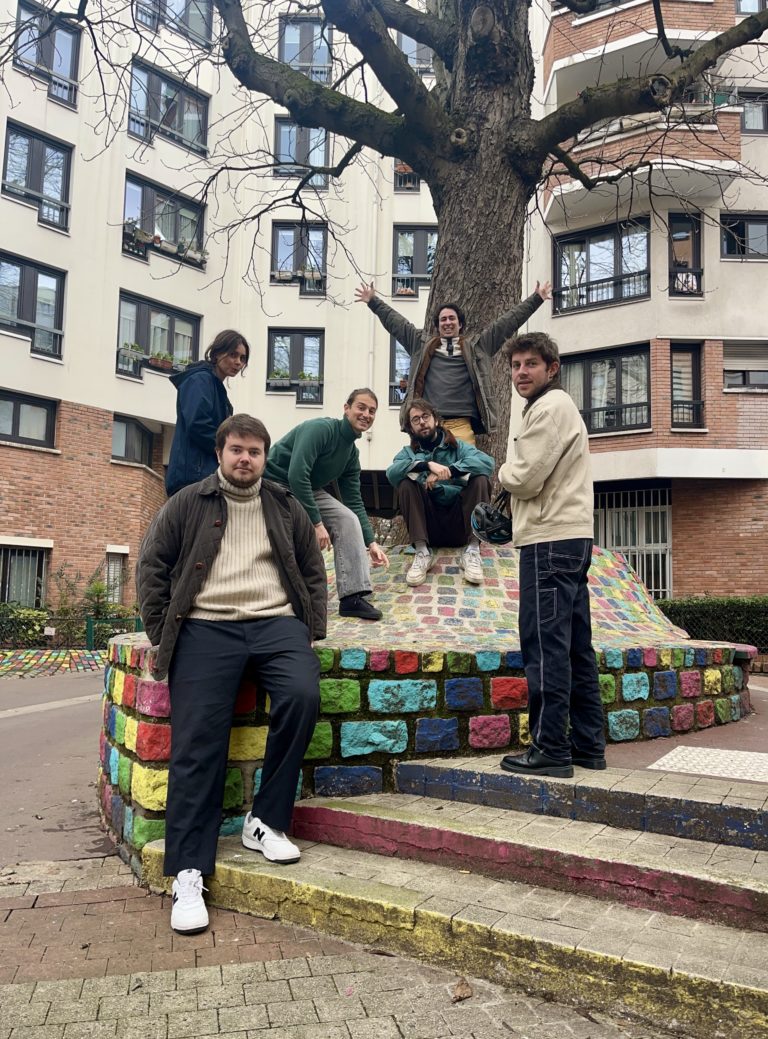
Radio Paradis's team – © Julien Chil Hagopian
In the face of the standardisation of music consumption, the rise of musical web radios such as Kiosk Radio or Lahmacun Radio represents a form of resistance in which uniqueness is embraced. Inspired by these pioneers, Radio Paradis was born in 2022 in a shared flat on Rue de Paradis, in the heart of the 10th arrondissement of Paris.
At the time, the problem was not only the standardisation of what we listened to, but also the gradual loss of our neighbourhood’s identity. Through a community-driven media platform, we use the unifying power of music to come together around local issues. Our own way of fighting back against the disappearing conviviality of urban spaces—our own way of reclaiming these spaces.
A Community Radio Shaped by Its Neighbourhood
Let us guide you through the maze of the 10th arrondissement/district, one of the most peculiar districts of Paris.
To the north, you will find the constant bustle of the two international train stations, where 250 million travellers pass through every year. Heading south through the Faubourg Saint-Denis, from 11 o'clock onwards, you can follow the smell of grilled meat from the Turkish and Kurdish restaurants that line the street. This landscape has been shaped by the waves of immigration since the 1970s. “I have never seen this much cultural diversity in one street anywhere else,” said Ruşan Filiztek during an interview, a Kurdish musician who can regularly be seen with his saz case on his back, enjoying a coffee on one of the terraces along the street near the Porte Saint-Denis. This gate opens the doors to another stage for shows that take place at night in the dark rooms of the theatres that have historically been located at the bottom of the street. Their performances enliven the evenings of the neighbourhood.
Leaving the Faubourg, we walk down the Rue du Château d’eau to the banks of the Canal Saint Martin, where African beauty salons stand next to trendy boutiques. Here, whether you want a braid or sourdough bread with pistachio and yuzu cream, you queue on the same pavement. Once at the canal, it’s a mad scramble to find a spot on the sunny bank, as if waterways will never cease to influence human behaviour.
Triumphant shouts, a ball bouncing on the tarmac, it's the basketball court! Perched on 144 Quai de Jemmapes, at the head of the canal, it federates a community of enthusiasts, one game at a time. This is the gateway to the Grange Aux Belles district, a district within the district, a village in its own right, and the place where some of the radio programmes are recorded.
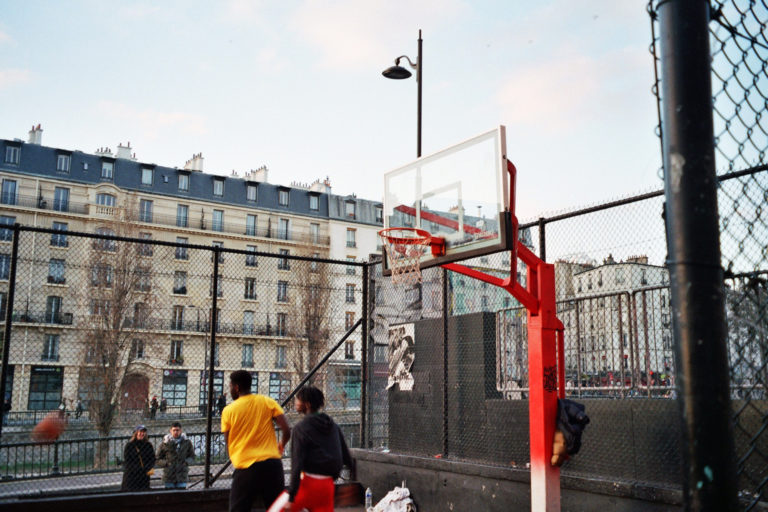
The 144 Quai de Jemmapes basketball court – © Julien Chil Hagopian
Radio Paradis is deeply rooted in this environment, keen to defend our vision of conviviality in a changing neighbourhood. Each month, we gather various local actors and artists of the music sector around a microphone to bring local issues and unique perspectives to the table. The content is produced directly by the community, with a shared desire to resist, each in their own way, against the individualism that is taking over urban spaces.
To achieve this mission, Radio Paradis works with residents who record their programmes in one of the two studios used by the association. The editorial line is clear: a unique musical universe and/or a link with the neighbourhood, two complementary approaches that bring together the residents.
A Studio Within the Neighbourhood
Our neighbourhood is a complex mosaic of over 80,000 residents, around 2,800 retailers, over 600 civil society organisations, 22 religious buildings, around 20 ethnic communities, over 12 theatres, 8 high schools, 7 middle schools, 6 concert halls, 5 public libraries, 3 cinemas, 3 hospitals, and a local town hall.
Step by step, we are trying to integrate this cultural wealth into our studio in the heart of la Grange Aux Belles, in the Paris Anim social centre run by the CRL10 association. Like the drop-in sessions organised by local political representatives, we offer regular radio recording sessions. Two formats are available;
On the one hand, local residents can book a slot to record an episode of their own show. Every month, for instance, you can listen to “En quête de démocratie” by the Tournons la Page neighbourhood association, or “Solidarités Jeunesses,” which discusses issues related to civic engagement. Another example: Father Paul Dollié, from the largest parish in the 10th arrondissement, is also coming to talk about the role of his church in the community. Political, environmental, religious, artistic, or scientific, no voice is excluded from this mosaic.
On the other hand, each month the members of Radio Paradis invite impactful local figures for interviews. Thanks to constant research into the latest news from the arrondissement, we welcome city officials, artists, and residents who shape the neighbourhood.
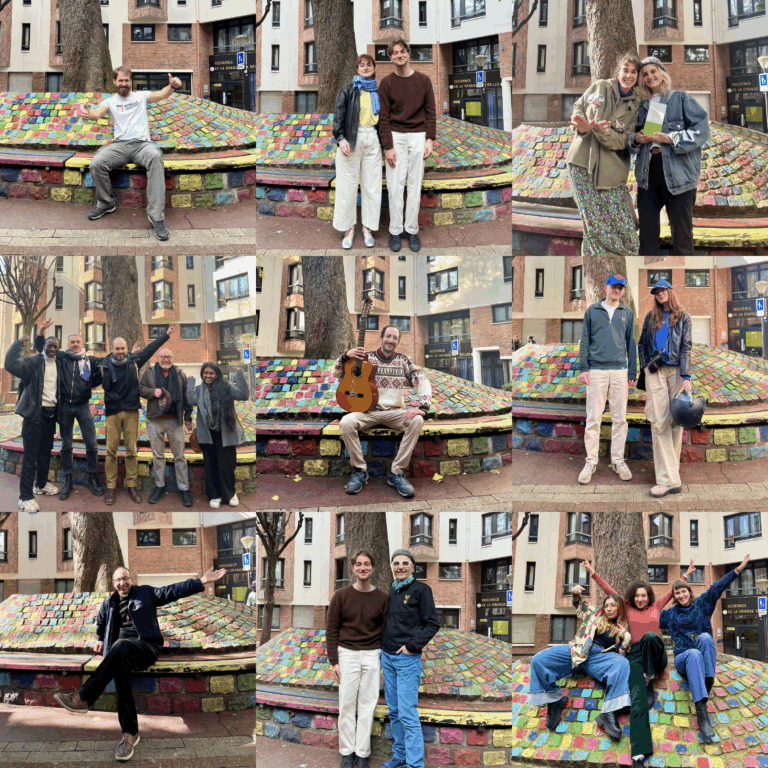
Some of the traditional pictures we do after each recording session at la Grange-aux-Belles – © Julien Chil Hagopian
Open to the public, each recording session is unique. They help to redefine a new space for encounters, bringing together people from the neighbourhood who rarely cross paths. A space enriched by the unifying power of music.
A Studio Designed for Musical Diversity
Directly inspired by the free radio movement of the 1970s, the studio where our musical shows are recorded is located on the 10th floor of a building on the edge of the 10th arrondissement of Paris. Set up in the living room of two members of the collective, this temporary studio offers a breath-taking view of the Sacré-Cœur and blazing sunsets.

Studio for our music recordings, at the border of the 10th district – © Julien Chil Hagopian
What happens in this studio every month is an act of resistance that defends music as a shared cultural object in all its diversity. Today, recommendation algorithms and the revenue models of streaming platforms contribute to the homogenisation of the way we consume music. In contrast, Radio Paradis offers a space for free expression, where eclecticism thrives and local voices are celebrated.
For example, DJ Soulist, one half of the duo Souleance, takes listeners on a dynamic sonic journey on his show “Panorama Radio Show”. Adou, on the other hand, goes beyond his usual selections with “Oups, I Played It Again!”, inspired by Laurent Garnier’s iconic show “It Is What It Is” on Radio Nova. As for Anaïs, she leads Fem in Mix, which highlights women DJs in the music industry. Lastly, Jérémy, Louis, Paul, and Victor come together monthly for the “Radio Paradis Crew” show, where they delve into themed explorations such as the monumental influence of dub on electronic music or the creative explosion of New York through salsa, hip hop, and house.
Every month, more than 15 artists take to the mic in this studio to share their projects or deliver a one-of-a-kind selection. A community brought together through music, one recording at a time.
Nevertheless, in January 2025, we were invited to present the radio during a neighbourhood council meeting. At the end of the meeting, someone in the audience asked us: “I’ve lived in the 10th arrondissement for over 20 years and I’ve never heard of Radio Paradis. How is this possible?”. That’s when we realised that studio recordings alone aren't enough to involve the residents. It was time to bring the studio out into the neighbourhood.
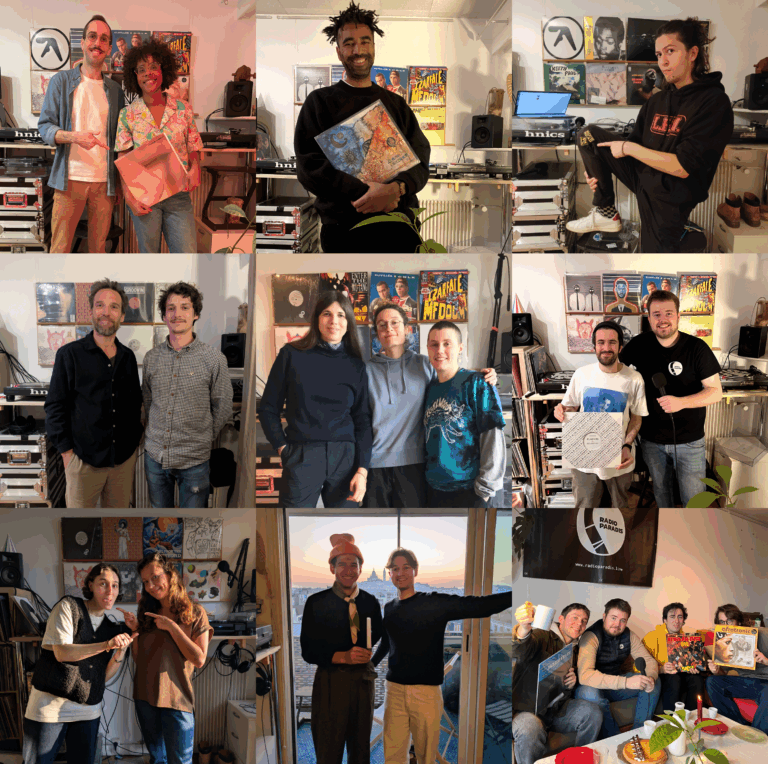
Some of the traditional pictures we do after each recording session in the studio – © Julien Chil Hagopian
A Sound System as a Gateway to the Neighbourhood
The Radio Paradis Soundsystem (designed by Louis Reine and Victor Tomasi) brings the station to the streets of the arrondissement. It acts as a real link between the local community and music, transforming public space into a place of encounter. Originally used in 1950s Jamaica, particularly in Kingston, these sound systems served as tools of resistance, amplifying a culture excluded from traditional institutions.
Inspired by this legacy, we built our own sound system for neighbourhood celebrations, using recycled wood from a nearby workshop (‘Le Chamodix’). This handcrafted setup, made in the 10th, is now available to local collectives in need of sound equipment to power their initiatives in public spaces.
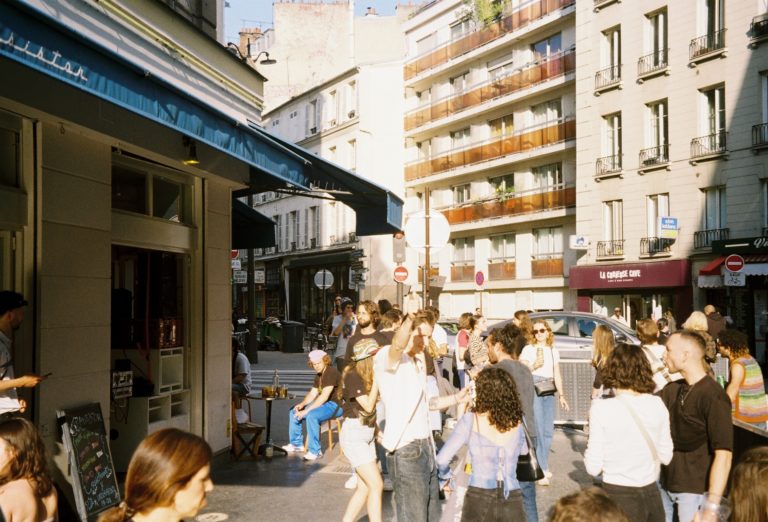
Le Soundsystem Radio Paradis used during the “Fête de la musique”, rue de paradis – © Julien Chil Hagopian
The next step for Radio Paradis will be to bring together our music and community recording sessions together in a single studio, open to everyone. A functional and cultural space dedicated to the exchange of music and ideas. In short, a new kind of town square for our arrondissement.
Published on April 29th, 2025
About the authors:
Radio Paradis’s team: Charlotte Guichard, Victor Tomasi, Colombe Brissonnet, Louis Reine, Paul Diacquenod, Manon Rouquette, Jérémy Berloty (co-founder), and Julien Chil Hagopian (founder).